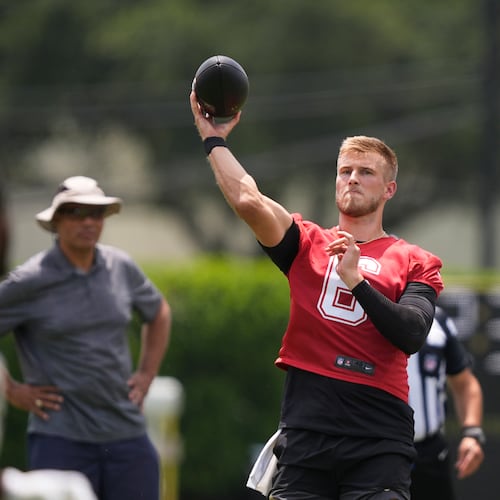Name; Pos.; Team; Penalties*
Patrick Peterson;CB;Cards;11
Willie Colon;G;Jets;10
Jake Matthews;T;Falcons;10
Robert Alford;CB;Falcons;9
Cortez Allen;CB;Steelers;9
Joe Haden;CB;Browns;9
Jerry Hughes;DE;Bills;8
Jordan Mills;T;Bears;8
Justin Pugh;T;Giants;8
Xavier Rhodes;CB;Vikings;8
Nate Solder;T;Patriots;8
*Includes penalties that were declined or offset.
It’s not easy for cornerbacks in the NFL.
The receivers are bigger than them, the rules do not favor them and the passes come at them more frequently.
“I don’t feel bad for them,” Falcons quarterback Matt Ryan said, laughing. “Our guys, maybe they should call (penalties) the other way. But everybody else, I don’t feel too bad. The size and speed of wide receivers across the league makes it difficult and the rules are set up the way they are.”
This is the NFL landscape on which Falcons cornerbacks Desmond Trufant and Robert Alford compete. The Falcons selected them in the first two rounds of the NFL draft with such challenges in mind.
At 6-foot, 190 pounds Trufant is slightly bigger than the typical cornerback; Alford (5-10, 186) is slightly smaller. Neither can match the size of the giant wide receivers they seem to line up against on a weekly basis.
“Huge human beings that can run,” Falcons secondary coach Tim Lewis said.
The latest big challenge for Trufant and Alford is Carolina rookie wide receiver Kelvin Benjamin (6-5, 240 pounds). The Falcons already twice faced the Tampa Bay duo of Vincent Jackson (6-5, 230) and Mike Evans (6-5, 231). Against the Bears it was Brandon Marshall (6-4, 230) and Alshon Jeffery (6-3, 216).
The Vikings featured Cordarrelle Patterson (6-2, 220) and the Saints had Marques Colston (6-4, 225) in the first meeting. Still to come for the Falcons: Cleveland’s Josh Gordon (6-3, 225) and Arizona’s Larry Fitzgerald (6-3, 218).
“They are taller than us and they weigh more than us so they are going to try to use their body and their arm length to get away from us to get separation,” Alford said. “Our technique will have to be on point. We are quick guys but they would rather just use their bodies and play basketball against us.”
Trufant and Alford have held up relatively well in coverage this season when factoring in the Falcons’ weak pass rush. Alford, though, has struggled to adjust to the new emphasis on defensive holding and illegal contact penalties—his nine penalties are tied for third-most in the NFL.
Alford and Trufant are going to have to get used to seeing bigger receivers during their careers because that seems to be trend.
Scouts Inc. averaged the measurements of all players at the NFL scouting combines from 2008-2012. Wide receivers and cornerbacks were similar or identical in measurements for strength (wide receivers bench pressed 225 pounds for an average of 15.4 times vs. 15.5 times for cornerbacks), 40-yard dash time (4.55 seconds for both), broad jump (10 feet vs. 10 feet, one inch) and vertical jump (35 inches for both).
But the biggest difference between wide receiver and cornerback prospects during those years was size. Wide receivers averaged 6-foot, ¾ inches and 202 pounds compared to 5-11 and 193.2 pounds for cornerbacks.
Lewis, who played for the Packers from 1983 until a neck injury ended his career in 1986, said there have always been big wide receivers. His contemporaries as a player included Al Toon (6-4, 205) and James Lofton (6-3, 192).
“Those guys could really run and that hasn’t changed (with big receivers),” Lewis said. “They’ve just gotten stronger and they are better athletes.”
Cornerbacks have gotten bigger, too, but can only be so big because they must change direction quickly and also run down field. The Scouts Inc. analysis of combine results showed that cornerbacks are significantly better at short-area agility drills than wide receivers.
Still, there are signs that big cornerbacks are in demand, especially with Richard Sherman (6-3, 195) starring for the Seahawks.
Lewis cited Sean Smith (6-3, 218), who got $12 million guaranteed to sign with the Chiefs last year. The Browns used a fourth-round pick in the last draft on Pierre Desir (6-1, 198) of NCAA Division II Lindenwood University and the Saints selected Stanley Jean-Baptiste (6-3, 218) in the second round out of Nebraska.
“The bottom line is those type of guys have become attractive to a lot of teams,” Lewis said. “We don’t have that necessarily. But what we do have is two very athletic guys that understand you’ve got to be able to think a little bit as a corner, too, and understand the angles and the leverage you have to maintain on those bigger guys.”
About the Author
Keep Reading
The Latest
Featured


